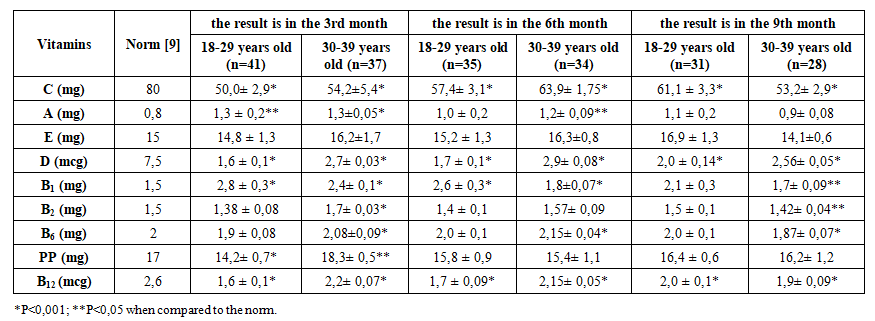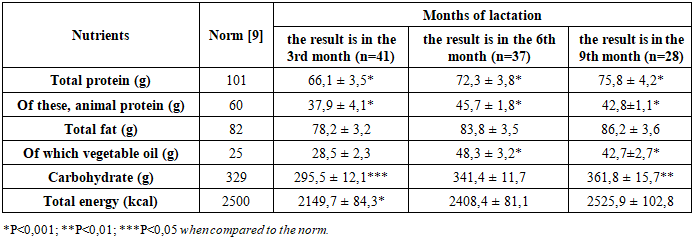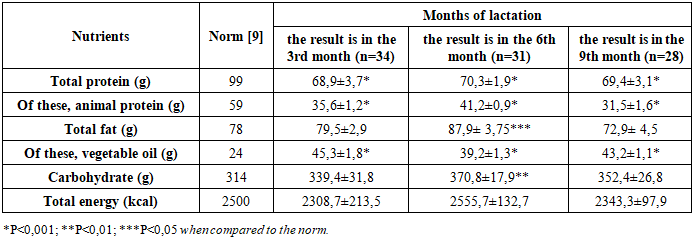-
Paper Information
- Previous Paper
- Paper Submission
-
Journal Information
- About This Journal
- Editorial Board
- Current Issue
- Archive
- Author Guidelines
- Contact Us
International Journal of Genetic Engineering
p-ISSN: 2167-7239 e-ISSN: 2167-7220
2025; 13(9): 182-186
doi:10.5923/j.ijge.20251309.03
Received: Aug. 17, 2025; Accepted: Sep. 12, 2025; Published: Sep. 20, 2025

Actual Nutrition of Lactating Women in Rural Conditions During Lactation and Its Analysis
Shoxsanam Baratova
PhD Student, Department of Human and Animal Physiology and Biochemistry, Samarkand State University, Samarkand, Uzbekistan
Correspondence to: Shoxsanam Baratova, PhD Student, Department of Human and Animal Physiology and Biochemistry, Samarkand State University, Samarkand, Uzbekistan.
| Email: |  |
Copyright © 2025 The Author(s). Published by Scientific & Academic Publishing.
This work is licensed under the Creative Commons Attribution International License (CC BY).
http://creativecommons.org/licenses/by/4.0/

The article is devoted to studying the intake of essential nutrients, minerals, and vitamins through the daily diet of lactating women (41 aged 18-29 and 34 aged 30-39) living in rural areas of Surkhandarya region. According to the obtained results, the supply of nutrients through the daily food of lactating women living in this area differs from the existing norms. In particular, compared to the existing standard, the respondents were provided 65.5-75.05% with protein, 93.5-112.7% with fat, 89.8-118.1% with carbohydrates, 29.8-50.3% with Ca, 112.7-131.6% with Mg, 111.8-137.6% with Fe, 63.7-90.7%, 70.6-87.7% with Zn, 21.2-37.0% with J, 62.5-79.9% with vitamins C, 112.5-162.5% with vitamin A, 94-112.7% with vitamin E, 21.3-38.7% with vitamin D, 113.3-186.7% with vitamin B1 %, 92-113.3 with vitamin B2 %, 93.5-107.5% with vitamin B6, 83.5-107.6% with vitamin PP, and 61.5-84.6% with vitamin B12. The identified situation indicates that there are imbalances in the nutrition and nutrient supply of lactating women living in rural areas of Surkhandarya region, one of the southern regions of our republic, and that research in this area should be conducted on a large scale in different regions of our republic.
Keywords: Lactation period, Lactating women, Daily diet, Macronutrients, Minerals, Vitamins
Cite this paper: Shoxsanam Baratova, Actual Nutrition of Lactating Women in Rural Conditions During Lactation and Its Analysis, International Journal of Genetic Engineering, Vol. 13 No. 9, 2025, pp. 182-186. doi: 10.5923/j.ijge.20251309.03.
1. Introduction
- The nutritional regimen of nursing mothers during lactation, including the quantity, quality, and nutritional value of foods consumed, directly affects both the mother's own physiological state and the biosynthesis and biochemical composition of her breast milk. At the same time, these factors also have a decisive impact on the health and development of the child. Breast milk is the only physiologically complete source of all the nutrients necessary for the growth and development of the child in optimal proportions. The qualitative and quantitative adequacy of nutrients in breast milk is a key factor in ensuring the normal growth of the child, the normal maturation of morphological and functional systems, and the correct course of physiological development processes [1].The nutrient requirements of lactating women depend on a number of individual and physiological factors, including the volume of milk produced during lactation, the mother's age, reproductive status (e.g., the interval between births), and the body's metabolic activity [2].The process of lactogenesis (breast milk production) requires significant energy expenditure for the female body, i.e. an additional 500 kcal of energy consumption per day. Therefore, the daily diet of nursing mothers should be higher in energy value than the usual diet. According to scientific recommendations, daily energy consumption during lactation should not be less than 2500-3000 kcal, and it should also be enriched with nutrients [3,4].Macronutrients (proteins, fats, carbohydrates) are the main source of energy necessary to meet the energy needs of the body. In addition, they provide the plastic (construction) material necessary for the synthesis, regeneration, growth and development of cells and tissues. Although micronutrients (vitamins, minerals) are not a direct source of energy, they play a catalytic (activating) role in all stages of metabolism, including the processes of energy acquisition and use. Therefore, without micronutrients, the normal transition of metabolic processes in the body is impossible [5].Insufficient protein intake by a lactating woman can negatively affect the composition of milk during lactation, in particular the concentration of casein protein. Casein protein is not only the main source of amino acids necessary for growth and development in children, but also plays a crucial role in the absorption and metabolism of calcium and phosphorus in the intestinal tract.The lactation period causes metabolic, morphological and hormonal adaptive changes in the body of a lactating woman, as this process is aimed at ensuring lactogenesis (milk synthesis) and galactopoiesis (milk secretion) in the mammary glands. Mineral substances necessary to maintain milk production at a physiological level, in particular calcium, are mobilized mainly from mineral depots in bone tissue. Due to this mechanism, the lactation period is associated with a loss of bone mass (osteopenia) and an increased risk of osteoporosis, which is the main pathophysiological cause of bone fragility in many nursing mothers [6].During lactation, insufficient coverage of macronutrients (proteins, fats, carbohydrates) along with micronutrients (vitamins and minerals) in the daily diet can lead to a number of negative consequences in the mother's body, including the risk of developing pathological conditions such as chronic fatigue, weakened immune function, alopecia (hair loss), and decreased bone mineral density (osteopenia) [7,8].In our republic, scientific data on the nutritional status and eating habits of lactating women have not been collected in sufficient quantities. Therefore, it is an urgent scientific and practical task to conduct a comprehensive study of the practical diet of lactating women living in different biogeographical regions of our country, the level of consumption of nutrients and their state of micro and macronutrient supply, and on the basis of this, to develop individualized dietary recommendations taking into account regional characteristics.Taking the above into account, during our observations, we aimed to study and assess the provision of macronutrients and micronutrients to lactating women in the villages of Angor district, Surkhandarya region, one of the southern regions of the Republic of Uzbekistan.
2. Materials and Methods
- Observations were conducted on 41 18-29 and 34 30-39-year-old lactating women living in Angor district of Surkhandarya region during the first 3, 6, and 9 months of the lactation period after childbirth. In participantes, the delivery was on time and healthy children were born. The average educational level of the respondents was secondary vocational college. Most of them are currently housewives. The amount of basic nutrients, minerals, and vitamins in the daily diet of lactating mothers was checked. Their actual diet was studied using a traditional questionnaire-survey method. The chemical composition of food products was calculated using special tables (SanQ va M №0016-21). The data from the questionnaires were mathematically calculated and statistically processed using the Windows Microsoft Excel program. The results were compared with relevant standards [9].
3. Results and Discussion
- This study analyzed the daily dietary patterns of nursing mothers living in the Angor district. The main focus of the study was to determine the amount of macronutrients and micronutrients in the daily food consumed. The following tables present the results of the main nutrient intake of the women participating in the research groups in this region.
|
|
 | Table 3. The amount of minerals in the daily dietary intake of breastfeeding women |
 | Table 4. The amount of vitamins in the daily dietary intake of breastfeeding women |
4. Conclusions
- In conclusion, we can say that there is an imbalance in the supply of macronutrients and micronutrients among lactating women living in the villages of Angor district, Surkhandarya region, one of the southern regions of the Republic of Uzbekistan.In particular, it was found that the total protein and animal protein content of the total protein content of all respondents in their daily diet was below the norm. The total fat intake of lactating women was close to the norm, but the amount of vegetable fat in the total fat content was higher than the norm.The norm of providing breastfeeding women with certain minerals is violated. The participants' daily intake of Ca, Fe, Zn and J is less than the norm, and the intake of P and Mg is more than the norm.It was found that the daily diet of respondents contained less than the norm of vitamins E, D, and B12, more than the norm of vitamins A and B1, and close to the norm of vitamins E, B2, B6, and PP (vitamin PP was 16.5% less than the norm in the 3rd month of lactation in 18-29 year olds).According to the obtained results, it was found that the most norm limits were violated in the 3rd month of the lactation period by lactating mothers aged 18-29.Studying the physiological supply of basic and additional nutrients to lactating women during lactation is important for maintaining and strengthening the health of the mother and child. In this regard, the formation of their rational nutrition and healthy lifestyle, and the promotion of understanding of the topic among them are important practical measures.
 Abstract
Abstract Reference
Reference Full-Text PDF
Full-Text PDF Full-text HTML
Full-text HTML
